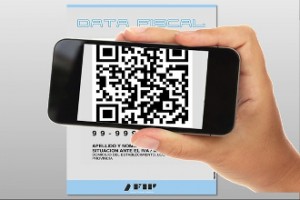And surely you don´t have anything to tell about this Ferrari?
Some innovations in the AFIP
 In a previous CIATalk post (Take your review now!) I commented how we had used the fast answer codes to get links to our review and some potential applications within the Tax Administration framework. Last Tuesday, August 28 in Buenos Aires, we had the opportunity to attend the presentation of a new mechanism that the always innovative AFIP is launching: the “Data Fiscal”. Ricardo Echegaray, Federal Administrator announced it in a press conference in which the agreement for the next CIAT Assembly in that City was also signed.
In a previous CIATalk post (Take your review now!) I commented how we had used the fast answer codes to get links to our review and some potential applications within the Tax Administration framework. Last Tuesday, August 28 in Buenos Aires, we had the opportunity to attend the presentation of a new mechanism that the always innovative AFIP is launching: the “Data Fiscal”. Ricardo Echegaray, Federal Administrator announced it in a press conference in which the agreement for the next CIAT Assembly in that City was also signed.
In Argentina, like in other countries, taxpayers must show in their premises some documents such as: registration certificates, products sale licenses, withholding agents credentials, last return, last payment, accreditation as subject to some special small taxpayer regime, identification of the number of employees registered in the social security, authorizations to issue certain invoice ranges, etc. The reliability of those documents, as well as the procedures to verify their authenticity or validity varies and also their purposes. Some are there to be verified by the tax administration or social security officials. Others are for the customers of those businesses so they can verify at the time of receiving an invoice, for example.
The AFIP is pushing for all, yes, all those documents to end up in the garbage. Instead, only one would be used: The “Data Fiscal”. A document which includes few elements: in readable characters for humans; minimum identification data for the business; and in a format easy to recognize but, difficult to read without help: a blur bar code. This one is easily decoded by several devices such as smart telephones or tablets. With the blur bar code reading using his/her smart telephone, any customer can get information such as the taxpayer´s identification, if he/she qualifies, if he/she can issue invoices, if he/she uses electronic invoices, or the number of employees registered in the social security system. Additionally and more important, with options conveniently located on the screen, the customer can report by himself with a click if the business physical address does not correspond to the place where the person is located; if the presence of more employees than the registered number is visible; or if when making a purchase he/she did not receive an invoice.
The neat visual aspect in the cashier´s space is an advantage and also, as reported when launching the program, in Argentina more than 25% of the population already has a smart telephone, so the potential number of “hidden agents” is considerable. I do not know details of the mechanisms oriented to motivate the common citizens to widely use the system and not only, for example, if they have received a bad treatment in some business. But for sure, it will quickly be adopted by taxpayers who hope to have no difficulties with the credits associated to their purchases, or by those citizens who want to make sure that the consumption tax that they paid in cash will have a greater probability of arriving at the correct destination.
By all means, the Tax Administration officers have, when capturing the QR Code, access to more information than the general public: Appropriate information to comply with their duties, including recommendations on certain elements that can or must be verified. Additionally, with the single reading, the AFIP will have access to the place where the officer is located and the exact time in which the visit was made. It is clear that the management control of those sweeping programs reaches therefore a new stage: it is a qualitative jump.
But the AFIP is also developing an additional control strategy. It is not about replacing the existing control processes, but to complement them with actions ex-ante, not directed to detect and sanction but to prevent the breach before it takes place. It is not about contracting the psychics of the Minority Report – the Steven Spielberg film – but to implement actions in which it is required to consult or request an authorization to do something before doing it. Among these, there is one related to the sale of expensive buildings and vehicles. In the case of the sale of buildings, the notary or the public agent who must inform the Administration on these operations through periodic reports will now report each operation online. Thus, for the sale of the building to proceed, two conditions must be met: the building will have to be identified among the assets of the seller in the so called Personal Goods statement, and the buyer must have reflected in his/hers last returns a contributive capacity in accordance with the value or the amount of the transaction. Similarly, the transference of luxury vehicles will require these same conditions to be met before the vehicle registry will allow completing the transaction. Otherwise, some explanations will have to be provided to the tax administration.
So, from now on, it is probable that any person, or perhaps more than one person, will have to start answering the question title for this post: Are you sure you don´t have anything to tell us about this Ferrari?
Greetings and good luck.
1,205 total views, 3 views today
